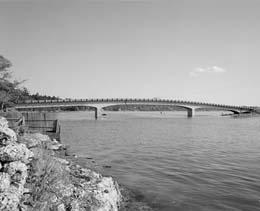On September 29, 1937, the Purdy Bridge is completed. The reinforced-concrete box-girder bridge carries State Route 302 over the strait between Henderson Bay and Burley Lagoon in the vicinity of Purdy, in Pierce County. The innovative bridge engineer Homer Hadley (1885-1967) had a large part in its design, and it is at the time considered the longest bridge of its kind. The Portland Dredging Company built it for Pierce County and later the Washington Department of Highways (now Washington State Department of Transportation) will buy it. The bridge will be put on the National Register of Historic Places.
Strong Tidal Currents
Henderson Bay, one of the many bays of Puget Sound, flows into Burley Lagoon, but its flow is almost blocked by Purdy Spit, a finger of beach that cuts across the mouth of the lagoon and "points" toward the town of Purdy on the eastern shore. The Purdy Bridge spans the spit and the 500-foot channel that flows between its tip and the opposite shore. At high tide the bay flows into the lagoon through the channel, and at low tide Purdy Creek flows in the channel. This is a place of strong tidal currents.
The concrete box-girder bridge was common in Europe, but quite uncommon in America. This is a rigid-frame bridge, one in which the deck is integral with the structure below. Each span is a hollow concrete box, attached to the other spans and supported by the piers. This type of bridge has been praised in engineering journals for its low cost and simple, graceful design.
The bridge, 550 feet long from end to end, is made up of five spans supported by four piers. The piers sit on sand-packed gravel (not on piles). The central span, over the channel, is 190 feet long. The spans on either side are 140 feet long. The deck is 6.5 inches thick.
Building and Rebuilding
This bridge was the fourth one built at this location. The town of Purdy was platted in 1885 and named after pioneer Tacoma grocer Ernest Purdy, who supplied lumber for the first school in the region. In 1892, Pierce County built the first bridge at Purdy Spit. This was a wooden structure supported by timber piles, with a swing span at the channel. The second bridge was built in 1905, but strong tidal currents washed away some of the pilings and it collapsed. The county replaced it using day labor.
In 1919 and 1920 the county again rebuilt the bridge and this time it had a steel swing-span. Nearby property owners initiated a lawsuit against it. These experiences and troubles influenced the form of the present Purdy Spit Bridge.

